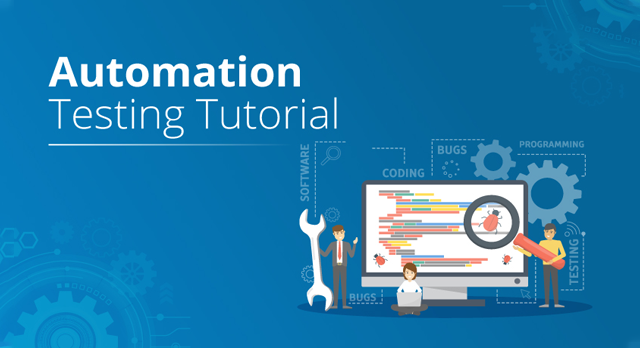Grasping Automation Testing: Tools, Strategies, and Benefits
Grasping Automation Testing: Tools, Strategies, and Benefits
Blog Article
From Manual to Automated Screening: A Comprehensive Overview to Transitioning Efficiently and Successfully
In the realm of software application testing, the change from guidebook to automated procedures has actually come to be a significantly essential transition for companies looking for to boost effectiveness and accuracy in their testing practices. As technology remains to advance, the requirement for seamless and effective automatic testing methods has actually never ever been a lot more pressing. The trip from handbook to automated testing is not without its challenges, but when come close to tactically and with a clear plan in mind, the benefits can be significant - automation testing. In this comprehensive overview, we will certainly check out essential actions and factors to consider necessary for a successful transition, from the first choice of tools to the assimilation of automation into existing workflows. Keep tuned to discover the insights that will certainly help lead the way for a smoother and more reliable testing procedure.
Advantages of Automated Checking
Automated testing supplies various benefits, improving performance and accuracy in software advancement processes. One main benefit is the substantial reduction in screening time. Automated examinations can be run simultaneously on several devices and running systems, substantially accelerating the testing phase contrasted to hands-on screening. This enhanced performance enables for faster comments on the quality of the software application, making it possible for designers to identify and resolve problems promptly.
In addition, automated screening guarantees a higher level of precision in finding issues. Uniformity in screening is additionally enhanced, as automated tests execute the same steps precisely each time they are run.
Picking the Right Devices

First of all, examine your goals and demands. Recognize the extent of your task, the modern technologies involved, and the ability of your group. This evaluation will certainly aid you establish the capacities and functions you need in your testing tools.
Secondly, take into consideration the compatibility of the devices with your existing processes and systems. Seamless integration with your current software development lifecycle is vital to guarantee a smooth shift to automation.
Additionally, evaluate the scalability and adaptability of the tools. As your testing requires develop, the tools need to have the ability to adapt and accommodate adjustments properly.
Last but not least, aspect in the assistance and community around the devices. Durable assistance and an energetic user area can give useful resources and assistance when applying automated screening. By thoroughly considering these aspects, you can pick the right devices that line up with your requirements and established the phase for a successful transition to automated screening.
Composing Reliable Test Manuscripts

When crafting test manuscripts, it is important to consider the certain requirements of the software program being evaluated and make certain that the scripts resolve all important functionalities. Clear and detailed calling conventions for test manuscripts and test instances can improve readability and maintainability. In addition, integrating mistake handling mechanisms within the examination manuscripts can help in recognizing and dealing with concerns promptly.
In addition, organizing test manuscripts into modular elements can boost reusability and scalability, minimizing redundancy and boosting efficiency in examination manuscript maintenance. Routine testimonials and updates to test scripts are critical to keep rate with evolving software application needs and functionalities. By complying with these concepts, testers can develop robust and reliable examination scripts that add considerably to the success of automated screening procedures.
Integrating Automation Into Workflows
Effective assimilation of automation devices into existing process enhances and enhances procedures performance within software development cycles. When integrating automation into process, it is critical to recognize repetitive tasks that can be automated to save time and minimize human mistake. By flawlessly incorporating automated screening devices like Selenium or Appium right into the software program growth lifecycle, groups can attain faster feedback on code changes, causing quicker insect discovery and resolution. This combination enables continual screening throughout the growth process, ensuring that any kind of concerns are recognized at an early stage, causing higher software quality. Furthermore, automation can be utilized to activate tests automatically after each code commit, giving instant validation and maximizing testers to concentrate on more complex circumstances. Appropriate integration of automation devices needs collaboration in between development, screening, and procedures teams to develop a unified process that maximizes performance and effectiveness in supplying high-quality software.
Guaranteeing a Smooth Transition
Efficiently transitioning to automated testing involves meticulous preparation and careful execution to optimize and decrease disruptions effectiveness in the software application growth process - automation testing. To make sure a smooth change, it is important to begin by conducting a thorough evaluation of the existing screening processes and recognizing areas where automation can bring the most considerable advantages. Engaging with all stakeholders early at the same time, consisting of developers, testers, and project managers, is essential for gathering support and buy-in for the automation initiative
Communication is key during this transition stage. Clear interaction of the objectives, advantages, and assumptions of automated screening assists to handle any type of resistance or issues that may arise. Additionally, providing adequate training and sources for group participants to upskill in automation tools and methods is important for making sure a successful transition.

Conclusion
To conclude, transitioning from handbook to automated screening provides countless benefits, including enhanced efficiency this content and integrity. By choosing the proper tools, composing efficient test manuscripts, and integrating automation effortlessly right into workflows, organizations can make certain a smooth and effective transition. It is vital to welcome automation as an important asset in software screening procedures to boost general top quality and productivity.
In the world of software program screening, the shift from manual to automated processes has actually come to be a significantly crucial shift for organizations looking for to boost effectiveness and accuracy in their screening techniques. Automated tests can be run concurrently on multiple devices and running systems, significantly speeding up the screening stage compared to manual testing. Uniformity in screening is likewise improved, as automated examinations implement the exact same steps specifically each time they are run.To make sure the successful execution of chosen testing devices, the creation of reliable examination scripts plays an essential function in validating the performance and performance of automated procedures - automation testing. By following these concepts, testers can create reliable and robust examination scripts that add considerably to the success of automated screening article source processes
Report this page